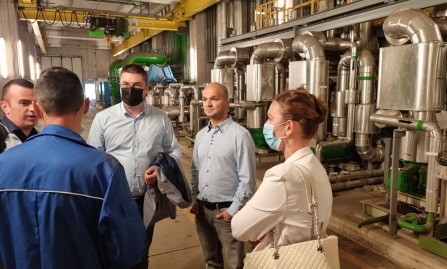EPCG representatives – Nikola Rovčanin, the Chief Executive Officer, Bojan Đordan, the Executive Officer of FU Generation, Mićun Milatović, the Executive Officer of the Directorate for Legal Affairs, Zoran Šljukić, the Manager of the Exploitation Department in TPP ‘Pljevlja’, Danica Cmiljanić, the Chief Engineer of the Chemical and Technological Plant in TPP ‘Pljevlja’ and Danilo Rutešić, the Manager of the Maintenance Department in HPP ‘Piva’ visited the thermal power plant ‘Šoštanj’ on August 20th, as part of the visit paid to Holding Slovenske Elektrane d.o.o. (HSE). They met with Mitja Tašler, the Chief Executive Officer of this facility and Branko Debeljak, the Technical Manager.
TPP 'Šoštanj' was built in the middle of the last century and once it owned six units. The two units are today in operation, given that, by the end of this year, Unit V is expected to be disconnected, its capacity amounting to 350 MW. It will be preserved and ready for the new commissioning, if the need arises. The remaining unit (VI) has 600 MW, commissioned in 2014/2015, and the cost of its construction had largely exceeded one billion Euros. The present TPP ‘Šoštanj’ covers more than the third of electricity volume generated in Slovenia.
According to the HSE's plan, TPP 'Šoštanj' should operate by the year of 2049, given that the Government of the Republic of Slovenia requires the plant to be out of operation not later than the year of 2033. Therefore, negotiations are being held and representatives of this company hope that they will succeed to extend the deadline by at least the year of 2040.
Concernig alternatives – in the event of a closure of the TPP – Slovenians consider construction of the new nuclear unit in the Municipality of Krško, and they seriously analyse effects of the possible introduction of a gas-fired plant. The fact that Slovenia, via Austria, already has an access to gas lines from Russia and Algeria, facilitates the position both of Slovenia and HSE in the context of a search for alternative solutions. There are two gas-fired units already existing in TPP 'Šoštanj', 42 MW each.
As estimated by the management of TPP 'Šoštanj', modernization of facilities – reconstruction which would result in reduced emissions of harmful substances into the air, provides possibility for the coal-fired facilities to continue to operate. The mentioned measurement of emissions of harmful substances – following reconstruction of a similar type – show that there is no fear of a negative impact onto the environment. Collection of thermal energy from this TPP solved the heating of Šoštanj and Velenje. The installed capacity of the heating system for these towns amounts to around 140 MW. Therefore, the overhead main line was constructed, running from the TPP to the town centres, and it follows the local river flow as the simplest and most natural route.
Exchange of ideas, information and know-how with our colleagues from Slovenia will also be of great use for the future projects implemented by EPCG, especially in the context of environmental retrofitting of TPP 'Pljevlja', i.e. decisions relating to the future of this plant crucially important for the electric-power stability and Montenegro's economy.
Press Releases
Announcements from other categories
-
EPCG BECOMES GENERAL SPONSOR OF MONTENEGRO’S VOLLEYBALL FEDERATION
3 years 9 months -
EPCG DONATED AUDIOMETER TO THE PRIMARY HEALTH CARE CENTRE OF BUDVA MUNICIPALITY
4 years 1 month -
30 million euros for dividend payment
4 years 6 months
-
11.12.23
Public Invitation for EPCG-Željezara Nikšić

-
26.07.23
DJUKANOVIC: PERSPECTIVES ON ELECTRICITY GENERATED BY SOLAR POWER PLANTS AS PART OF SOLARI 3000+ AND 500+ PROJECT

-
28.10.22
XXV EXTRAORDINARY EPCG SHAREHOLDERS’ MEETING TOOK PLACE

-
28.10.22
FROM THE PROFESSIONAL POINT OF VIEW: EPCG IN THE CONTEXT OF THE GLOBAL ENERGY CRISIS

- Home
- Media center
- Press Releases
- EPCG REPRESENTATIVES VISITED TPP 'ŠOŠTANJ' IN SLOVENIA






